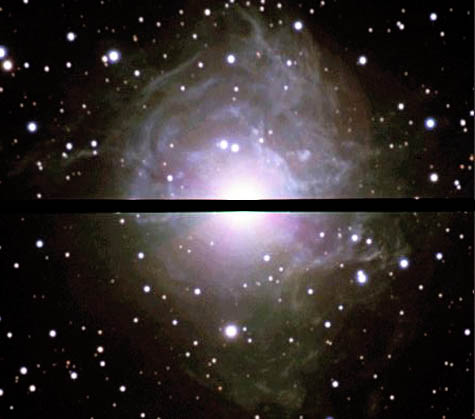Space/Drive
While packing up the apartment here and getting ready not only for another move but for an impending flight to Melbourne, I keep stumbling upon interesting old news clippings, quotations, and articles that I've saved, printed out, or otherwise written down in a notebook somewhere.
This afternoon, for instance, it was a short piece from New Scientist, originally published back in September 2008.
 [Image: The Cepheid Variable RS Pup].
[Image: The Cepheid Variable RS Pup].
Apparently, all those stars out there might be something more than mere heavenly bodies.
That is, "the galactic equivalent of the internet," if there is such a thing, might take the form of manipulated stars. What kind of stars? Cepheid variables, or "stars that vary regularly in brightness."
This regular dimming and brightening could be used as a way both to encode and broadcast information.
From the article:
The print version of the article differs a bit from the online one, and I'm quoting the print version here: "There are over 500 cepheids in the Milky Way, and countless more in nearby galaxies, so data could be shuffled around as in a computer network."
Overlooking some of the more basic questions here – such as why on earth is this kind of cannabinoid speculation being printed in a science magazine? – the idea that information is being relayed back and forth, from star to star, as if inside some vast celestial harddrive, raised at least my eyebrows.
What messages, or fragments of messages, might we be witnessing every night? And if there are no messages, yet we transcribe those flickering astral patterns nonetheless, what unexpected literatures of deep space might we think we've been translating?
(Earlier on BLDGBLOG: Planet Harddrive).
This afternoon, for instance, it was a short piece from New Scientist, originally published back in September 2008.
 [Image: The Cepheid Variable RS Pup].
[Image: The Cepheid Variable RS Pup].Apparently, all those stars out there might be something more than mere heavenly bodies.
That is, "the galactic equivalent of the internet," if there is such a thing, might take the form of manipulated stars. What kind of stars? Cepheid variables, or "stars that vary regularly in brightness."
This regular dimming and brightening could be used as a way both to encode and broadcast information.
From the article:
- Crucially, these "Cepheid variables" are so luminous they can be seen as far away as 60 million light years. Jolting the star with a kick of energy – possibly by shooting it with a beam of high-energy particles called neutrinos – could advance the pulsation by causing its core to heat up and expand, [some scientists] say. That could shorten its brightness cycle – just as an electric stimulus to a human heart at the right time can advance a heartbeat. The normal and shortened cycles could be used to encode binary "0"s and "1"s.
The print version of the article differs a bit from the online one, and I'm quoting the print version here: "There are over 500 cepheids in the Milky Way, and countless more in nearby galaxies, so data could be shuffled around as in a computer network."
Overlooking some of the more basic questions here – such as why on earth is this kind of cannabinoid speculation being printed in a science magazine? – the idea that information is being relayed back and forth, from star to star, as if inside some vast celestial harddrive, raised at least my eyebrows.
What messages, or fragments of messages, might we be witnessing every night? And if there are no messages, yet we transcribe those flickering astral patterns nonetheless, what unexpected literatures of deep space might we think we've been translating?
(Earlier on BLDGBLOG: Planet Harddrive).





Comments are moderated.
If it's not spam, it will appear here shortly!
This isn't far off from Seth Lloyd's "Programming the Universe" which explores quantum computing and the possibility that we could consider the entire universe one gigantic quantum computer.
thanks
--------
arcilook.com
I stumbled across that article as well and I've been working out the math for the last few months. I'm fairly certain I've distilled the repeating message of these star-systems down to their "gist."
And the answer?
42.
I was just going to suggest "42" for a viable result of deep space's literature. Too bad someone beat me to it!
I'm from Melbourne too!
You should definitely visit the new Melbourne Recital Centre and MTC Theatre project which has just been completed.
Are you giving and talks/lectures whilst in town?
Anonymous, I'll be speaking at the National Architecture Conference mostly, and doing some peripheral stuff (parties!), but don't have any other lectures set up. Hopefully just getting over jetlag! And enjoying my first time in the southern hemisphere... Can't wait to see Melbourne, though.
Geoff
this idea is explored in a slightly different version [brown dwarfs] in Stross' book _Accelerando_
Cheers-
Ed
Post a Comment